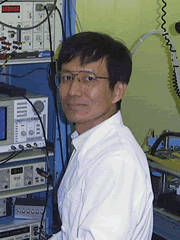Profiles and Activities
Profile
|
|
||||||||||||||||
Courses In Charge
| General Physiology |
|---|
| The living things, including men, have a variety of physiological functions to live in a variety of environments. There resides a common rule that underlies the activities of the life and the specific mechanisms which have been acquired by the living things to survive in different environments. In this course, students will learn on the physiological functions of the cell, the organ and the whole body of the living things, then understand how they are integrated to adapt or evolve in the environment. |
| Introduction to System Biology |
| The living things, including men, receive a various kinds of information from the outer world, appropriately process them and perform or behave to adapt to the world. To understand how the animals accept the world and how they adapt to it, students will learn on the sensory and motor systems of animals and by integrating them, how the animals behave appropriately in the world. |
| Physiological Laboratory Course |
| To understand the mechanisms and functions of human body, the course contains several basic physiological experiments including, muscle activity recording (electromyogram, EMG), measurement of touch sensation, or some autonomic functions. |
Main Research
| Our laboratory aims to understand the neural mechanisms for the regulation of sleep. The approach is mainly based on a recording of neuronal activity from unanesthetized, sleeping animals (rats and mice), combined with neuroanatomical and neurochemical methods. The main subjects of our research are; ● Mechanisms for REM sleep regulation The interaction of cholinergic and monoaminergic neurons in the brainstem are crucial for regulation of REM sleep. In addition, we would elucidate the whole aspect of REM sleep regulation, considering the GABAergic, glutamatergic and other types of neurons not only in the brainstem, but in the hypothalamus, limbic system or medulla. ● Autonomic function during REM sleep During REM sleep, we have a dream and the brain is activated. Various kinds of autonomic functions, heart rate, respiration or blood pressure fluctuate dramatically. Penile erection also occurs during REM sleep. To elucidate the mechanisms for dreaming, we are studying the mechanisms for blood pressure fluctuation and penile erection during REM sleep. ● Muscular tonus and REM sleep During REM sleep, the muscular tonus completely disappeared. In some patinas with sleep disorder (narcolepsy), such an attack occurs even during waking (cataplexy). Our interest is on the regulation of muscular tonus during waking and REM sleep, how the cataplexy occurs in narcoleptic patients and how it is avoided in normal subjects. ● Acupuncture and sleep Although oriental medicine has some therapeutic effect on some diseases, the physiological bases are scarcely elucidated. We found that the acupuncture stimulation to the spinal bone (sacral segment) facilitates sleep states and now examining its mechanism in cellular level. |
Introduction of Laboratory
Recent Writings, etc.
| 1. | Kodama T. and Koyama Y. Nitric oxide from the laterodorsal tegmental neurons: Its possible retrograde modulation on norepinephrine release from the axon terminal of the locus coeruleus neurons. Neuroscience 138: 245-256, 2006. |
| 2. | Takakusaki K., Takahashi K., Saitoh K., Hirofumi Harada H., Toshikatsu Okumura T., Kayama Y., Koyama Y. Orexinergic projections to the midbrain mediate alternation of emotional behavioral states from locomotion to cataplexy. J. Physiol. 568:1003-1020, 2005. |
| 3. | Hui Wang, Yoshiyuki Tanaka, Eiich Jodo, Yukihiko Kayama, Akihiro Kawauchi, Tsuneharu Miki , Manabu Otsuki, Yoshimasa Koyama. Acupuncture stimulation to the sacral segment affects the state of vigilance in rats. Neurosci. Res 57: 531-537, 2007. |


